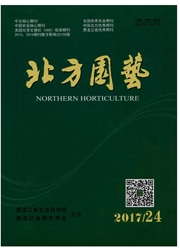

 中文摘要:
中文摘要:
为了获取在水分优化管理条件下合理的氮肥施用量,研究了冬、春茬和秋、冬茬日光温室黄瓜生产中不同施氮量对黄瓜产量及品质的影响。以农民经验水氮管理为对照,冬、春茬为N 840 kg/hm^2+水450m^3/(hm^2·次),秋、冬茬为N 465 kg/hm^2+水450 m^3/(hm^2·次)(I1N1);在优化水分管理条件下300 m^3/(hm^2·次),设计了3个施氮水平,冬、春茬分别为N 840 kg/hm^2(I2N1)、N 240 kg/hm^2(I2N2)和N0(I2N3);秋、冬茬分别为N 465 kg/hm^2(I2N1)、N 50 kg/hm^2(I2N2)和N0(I2N3)。结果表明:冬、春茬的I2N2组合的产量比I2N1I、2N3的产量分别高12.9%、41.0%,与I1N1相比差异不显著;秋、冬茬I2N2组合的产量比I2N1高8.2%,与I1N1及I2N3处理相比,产量差异不显著。同时,I2N2组合提高了果实中VC及可溶性糖含量,降低了果实中硝酸盐,亚硝酸盐及单宁含量。综合冬、春茬和秋、冬茬试验中产量及品质2个因素,当灌水量为300 m^3/(hm^2·次)时,冬、春茬施氮量N 240 kg/hm^2、秋、冬茬施氮量N 50 kg/hm^2的I2N2能够获得最好栽培效果,水氮利用效率最高。
 英文摘要:
英文摘要:
In order to get the reasonable nitrogen utilization in the optimum water management,the paper studied that the effect of different nitrogen(N)and irrigation(I)combinations on yield and fruit quality.The experiential water and nitrogen(I1N1)treatment was as control,which were 840 kg/hm^2 nitrogen and 450 m^3/hm^2 water per time in the winter-spring period,and 465 kg/hm^2 nitrogen and 450 m^3/hm^2 water per time in the autumn winter period.Three treatments were design under the optimum water management condition(300 m^3/hm^2 water per time).They were I2N1,I2N2 and I2N3,whose nitrogen utilization amount were 840 kg/hm^2,240 kg/hm^2 and 0 kg/hm^2 in winter spring period separately,and 465 kg/hm^2,50 kg/hm^2 and 0 kg/hm^2 in autumn winter period separately.The results showed that in the winter-spring period,I2N2 had higher yield than I2N1,I2N3 by 12.9%,41.0%respectively,but had no significant difference with I1N1.The yield I2N2 was no significant difference with I1N1 and I2N3,but higher than I2N1 significantly in the autumn-winter period.In addition,ascorbic acid and soluble sugar contents were highest in I2N2,while contents of nitrite,nitrate and tannin were lower than other treatments.These results suggested under the optimum water management(300 m^3/hm^2 water per time)situation,the I2N2 could improve crop yield and fruit quality,whose nitrogen utilization amount were 240 kg/hm^2 in the winter-spring period and 50 kg/hm^2 in the autumn-winter period.
 同期刊论文项目
同期刊论文项目
 同项目期刊论文
同项目期刊论文
 Alternate furrow irrigation and nitrogen level effects on migration of water and nitrate-nitrogen in
Alternate furrow irrigation and nitrogen level effects on migration of water and nitrate-nitrogen in Spatial variation of climatology monthly crop reference evapotranspiration and sensitivity coefficie
Spatial variation of climatology monthly crop reference evapotranspiration and sensitivity coefficie Response of evapotranspiration and yield to planting density of solar greenhouse grown tomato in nor
Response of evapotranspiration and yield to planting density of solar greenhouse grown tomato in nor Alternate Furrow Irrigation: A Practical Way to Improve Grape Quality and Water Use Efficiency in Ar
Alternate Furrow Irrigation: A Practical Way to Improve Grape Quality and Water Use Efficiency in Ar Relationship between environmental factor and maximum daily stem shrinkage in apple tree in arid reg
Relationship between environmental factor and maximum daily stem shrinkage in apple tree in arid reg Spatiotemporal variation of crown-scale stomatal conductance in an arid Vitis vinifera L. cv. Merlot
Spatiotemporal variation of crown-scale stomatal conductance in an arid Vitis vinifera L. cv. Merlot How does plasmalemma surface area accommodate alterations in guard cell volume during stomatal closi
How does plasmalemma surface area accommodate alterations in guard cell volume during stomatal closi Excretion and folding of plasmalemma function to accommodate alterations in guard cell volume during
Excretion and folding of plasmalemma function to accommodate alterations in guard cell volume during 期刊信息
期刊信息
